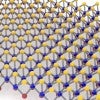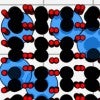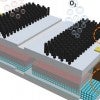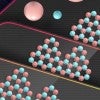
2D sandwich sees molecules with clarity
A 2D platform of molybdenum, sulfur and selenium is adept at detecting biomolecules via surface-enhanced Raman spectroscopy. Its nonmetallic nature helps by curtailing background noise.

2D sandwich sees molecules with clarity
A 2D platform of molybdenum, sulfur and selenium is adept at detecting biomolecules via surface-enhanced Raman spectroscopy. Its nonmetallic nature helps by curtailing background noise.

2D oxide flakes pick up surprise electrical properties
Rice University researchers find evidence of piezoelectricity in lab-grown, two-dimensional flakes of molybdenum dioxide.

Rice faculty part of Baylor Superfund program
A $10 million federal grant establishes a center to study how toxic chemicals from Superfund sites impact preterm births.

Water-splitting module a source of perpetual energy
Rice University researchers have integrated high-efficiency solar cells and electrode catalysts into an efficient, low-cost device that splits water to produce hydrogen fuel.

Rice engineers: Make wastewater drinkable again
Delivering water to city dwellers can become far more efficient, according to Rice University researchers who say it should involve a healthy level of recycled wastewater.

Rice wins federal grant to advance sickle cell disease therapy
A Rice University lab has won a prestigious National Institutes of Health grant to pursue gene-editing research it hopes will lead to a cure for sickle cell disease (SCD).

As the COVID-19 crisis plays out, Rice University faculty have been proactively making the best of a difficult situation for their students.

Heart nanofibers in STAT Madness semifinals
Texas Heart Institute and Rice University’s heart-saving nanotube fibers have advanced to the semifinal round of STAT Madness.

Heart nanofibers in STAT Madness quarterfinals
Texas Heart Institute and Rice University’s heart-saving nanotube fibers have advanced to the quarterfinal round of STAT Madness.

Heart nanofiber project makes STAT Madness round 3
A Texas Heart Institute/Rice project to use nanotube fibers to repair damaged hearts advances to round 3 of STAT Madness.

Heart nanofibers make STAT Madness Round 2
The Rice/Texas Heart Institute project to use nanotube fibers to repair damaged hearts makes Round 2 of STAT Madness.

A small step for atoms, a giant leap for microelectronics
Rice materials scientist Boris Yakobson and colleagues in Taiwan and China report in Nature on making large single-crystal sheets of hexagonal boron nitride, touted as a key insulator in future two-dimensional electronics.

Heart nanofiber breakthrough awaits your STAT Madness vote
Joint Texas Heart Institute/Rice University research into using carbon nanotube fibers to bridge damaged areas of hearts is part of this year's STAT Madness, a competition to choose the year's best university-based bioscience project.